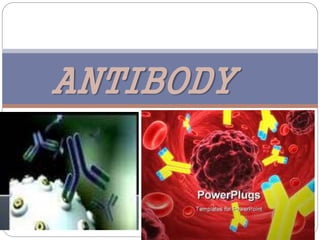
Antibodies
- 1. ANTIBODY
- 2. Antibody A protien formed in response to antigen. Belong to a group of proteins called immunoglobulins (Ig) The pivotal reagent common to all immunohistochemical techniques. Soluble immunoglobulin of
- 3. History Initially, Antibodies were identified only by their electrical charge Since the 1890s, immunologists have known that the molecules of humoral immunity are present in serum. In 1939, Tiselius and Kabat performed electrophoretic studies with rabbit antiserum specific for ovalbumin. They found that electrophoresis of serum from unimmunized rabbits resolved serum proteins into four dominant families of differing mobility.
- 4. The albumins were the fastest-migrating (most negatively charged) fraction. They followed by the alpha- (a), beta- (b), and gamma- (g) globulins.
- 5. Then hyperimmunized rabbits with hen ovalbumin to get a strong antibody response. The electrophoresed the immune serum, they observed a large increase in the gamma-globulin fraction. Hence concluded that antibodies were gamma-globulins.
- 6. The Structure Called as monomer due to simple structure. Consists of two chains of polypeptides, each linked to each other by disulphide bonds.
- 7. Composed of two identical heavy chains (H) and two identical light chains (L). H chain with a molecular weight of 50,000 daltons and L chain of 25,000. Covalent interchain disulfide bridges join L to H and H to H chains to form a Y-shaped molecules. The end portion of the Y’s arm called variable(V) region. The stem is called constant (C) or Fc region.
- 8. The H chains differ in antigenic and structural properties, which determine the class and subclass of the molecule. The two L chains are either of type kappa (κ) or lambda (λ) and the distribution of this differs in all Ig classes, subclasses, between different species. By participating in the tertiary structure, they confer greater stability and can assume T shape.
- 10. The chemical structure of antibodies explains three functions of antibodies: Binding versatility Binding specificity and Biological activity.
- 11. Immunoglobulins comprise five major classes IgG IgA IgM IgD IgE In decreasing quantity found in plasma or serum
- 13. The most frequently utilized antibodies in immunohistochemistry IgG IgM
- 14. IgG Most common in serum. Accounts to 80% of the total i.e,10-20mg in 1ml of serum. The heavy chains of IgG are denoted as gamma (γ) chains. Molecular Weight = 150 kDa IgG has the general formula of γ2 κ2 or γ2 λ2.
- 15. It is composed of two γ heavy chains, and two light chains of either type κ or type λ. On the basis of antigenic differences, IgG can be classsified as IgG1, IgG2, IgG3 and IgG4. Within two weeks after injection, they usually predominate. Have a mean survival of approximately three weeks.
- 17. Role Readily crosses the walls of blood vessels and enter tissue fluids. Eg: Maternal IgG can cross the plcenta and confer passive immunity to the foetus Protects from circulating bacteria and virus. Neutralize bacterial toxins. Trigger the complement system. Enhances the effectiveness of phagocytic cells.
- 18. IgM Makes up to 5% of antibody serum. General formula expressed as (μ2 κ 2)5 or (μ 2 λ 2)5. MW approximately 900 kDa, five subunits of approximately 180 kDa each. Each subunit is linked by a sulfhydryl-rich peptide, the J chain (15 kDa). The J-chains contribute to the integrity and stability of the pentamer.
- 20. IgM is the first humoral antibody detectable on the surface of develoing ß-lymphocytes. Secreted to blood during primary antibody responsse. Has a total of 10 antigen binding sites along with J chain. Have a relatively short half-life of only four to six days.
- 21. Treatment of pentameric IgM with 0.1% mercaptoethanol cleaves the disulfide bridges. Subclasses • IgM1 • IgM2
- 22. Role Agglutinates bacteria Activates complement Enhances ingestion of pathogens by phagocytic cells. Special antibodies like red blood cells agglutinins and heterophile antibodies.
- 23. IgA Constitutes about 10-12%. Molecular weight of 60,000 Daltons. Proteins of respiratory, gastrointestinal mucous membrane and external body secretion. Predominant Ig in secretions - milk, saliva, tears, mucus. Exists as monomer, dimer and polymer. Prevent the attachment of pathogens
- 25. IgA transport across cell (Transcytosis)
- 26. IgD Make up to only 0.2% Molecular weight is 1,80,000 daltons. Acts as a primer receptors for specific antigens on foetal lymphocytes. Functions Regulates the synthesis of other Ig Foetal antigen receptors
- 27. IgE Makes up to only 0.002%. Binds tightly by the stem region to receptors. During reaction releases histamine and other chemical mediation. Participate in immediate hypersensitivities reations. Ex. Asthma, anaphylaxis, hives. Destruct the pathogens.
- 28. Cross-Linkage of Bound IgE Antibody with Allergen Causes
- 29. Antibody production Produced by White blood cells i.e, B cells (B lymphocytes) of stem cells in bone marrow. Activated in the presence of antigen and produces plasma cells. Plasma cells create antibodies that are specific to specific antigen. Once the infection is under control antibody production decreases and circulates in lower concentration.
- 30. Polyclonal Antibodies Heterogeneous mixture of antibodies directed against various epitopes of the same antigen. Generated by different B-cell clones of the animal. Rabbits are frequently the species of choice in polyclonal antibody production
- 32. Monoclonal antibodies Homogeneous population of immunoglobulin directed against a single epitope. The antibodies are generated by a single B- cell clone from one animal. Immunize Animal With Antigen Multiple Clones Are Generated. Good For In Vivo Most commonly produced in mice and rabbits.
- 34. Uses As antiviral antibodies. Eg: diagnosis of influenza virus type for treating rabies. As a diagnostic reagent in clinical biochemistry. For the purification of protein products. Therapeutically to overcome the unwanted effects of immune system. Eg: Rejection in kidney transplanting.